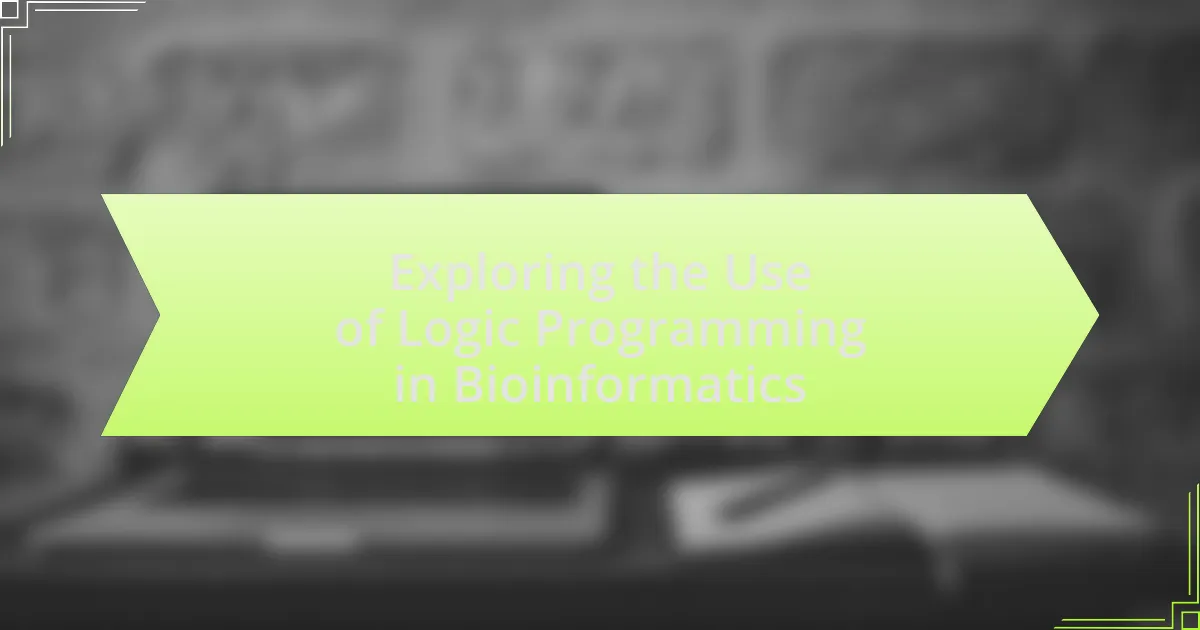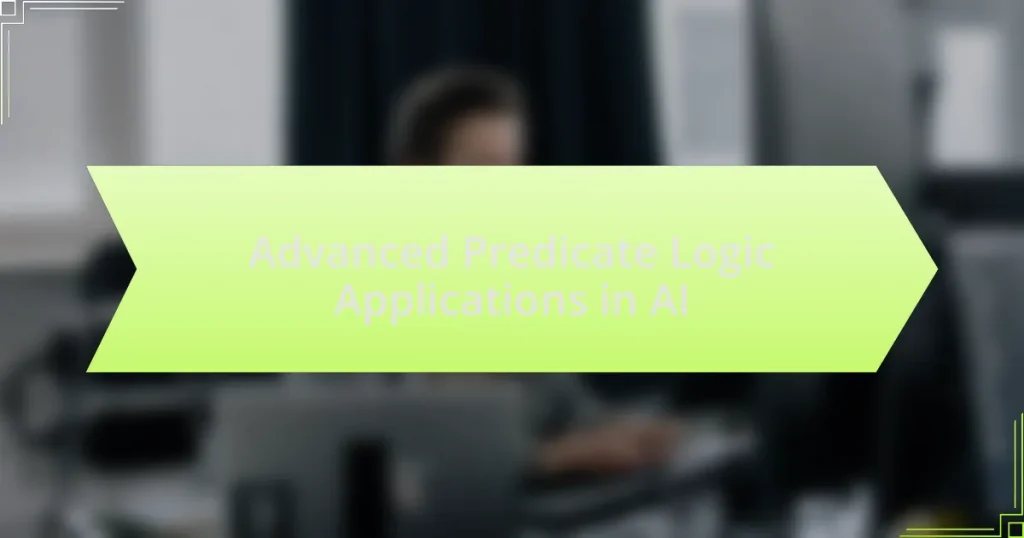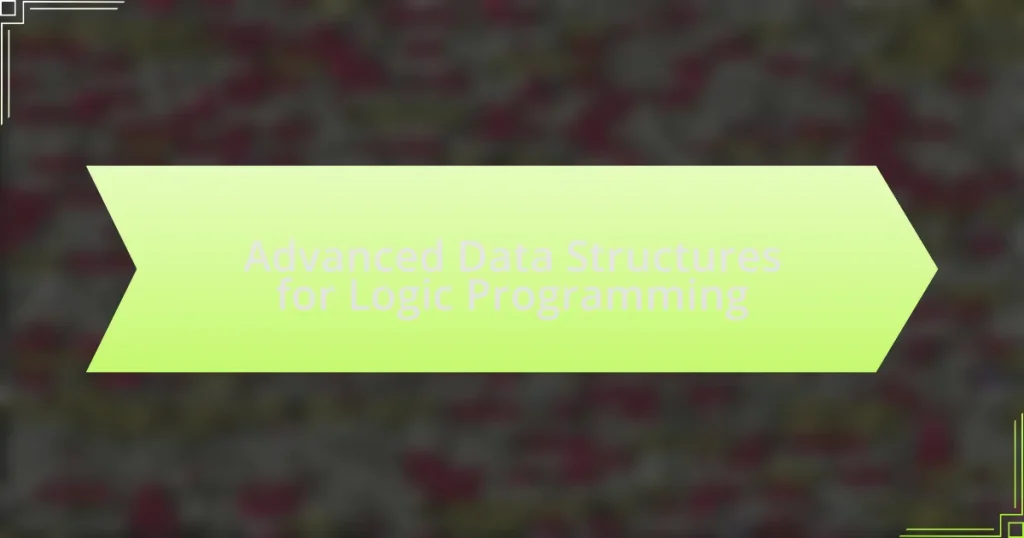Logic programming is a computational paradigm that applies formal logic to represent and reason about biological data and processes in bioinformatics. This article explores the principles and applications of logic programming, particularly its role in modeling complex biological systems such as genetic networks and protein interactions. Key topics include the effectiveness of logic programming in gene prediction, protein structure prediction, and data analysis, as well as the challenges and limitations faced in integrating this approach with existing bioinformatics tools. The article also highlights future prospects and emerging trends, emphasizing the importance of interdisciplinary collaboration and advancements in technology for enhancing the use of logic programming in bioinformatics.
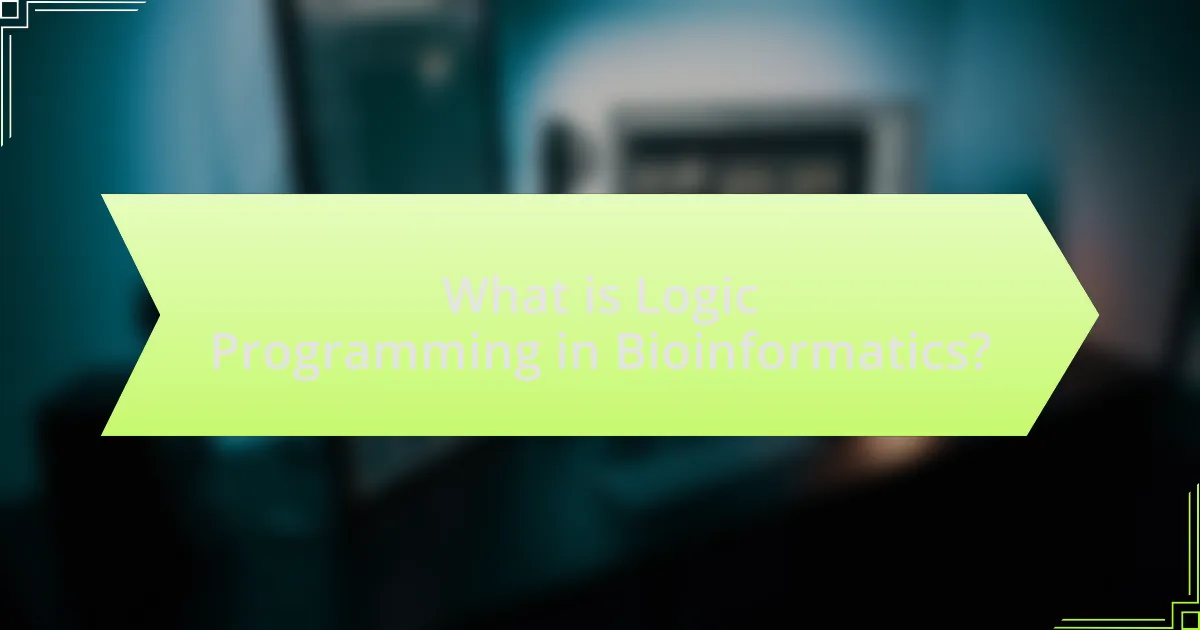
What is Logic Programming in Bioinformatics?
Logic programming in bioinformatics is a computational paradigm that utilizes formal logic to represent and reason about biological data and processes. This approach allows researchers to model complex biological systems, such as genetic networks and protein interactions, by expressing relationships and rules in a logical framework. For instance, Prolog, a common logic programming language, enables the encoding of biological knowledge and facilitates automated reasoning, which can lead to new insights in areas like genomics and systems biology. The effectiveness of logic programming in bioinformatics is evidenced by its application in tasks such as gene prediction and pathway analysis, where it has been shown to improve accuracy and efficiency in data interpretation.
How does Logic Programming apply to Bioinformatics?
Logic programming applies to bioinformatics by enabling the representation and reasoning of complex biological data through formal logic systems. This approach allows researchers to model biological processes, such as gene regulation and protein interactions, using rules and facts that can be systematically queried and inferred. For instance, Prolog, a common logic programming language, has been utilized to develop algorithms for analyzing genetic sequences and predicting protein structures, demonstrating its effectiveness in handling the intricate relationships inherent in biological data.
What are the fundamental principles of Logic Programming?
The fundamental principles of Logic Programming include the use of formal logic as a programming paradigm, where programs are expressed in terms of relations and rules. Logic Programming is based on the concepts of facts, rules, and queries, allowing for declarative problem-solving. The primary proof of its effectiveness is seen in its application in various fields, including artificial intelligence and bioinformatics, where it enables complex data manipulation and reasoning through logical inference.
How does Logic Programming differ from other programming paradigms in Bioinformatics?
Logic programming differs from other programming paradigms in bioinformatics by emphasizing declarative problem-solving over procedural coding. In logic programming, such as Prolog, users define relationships and rules, allowing the system to infer solutions based on logical reasoning, which contrasts with imperative paradigms that require explicit step-by-step instructions. This approach is particularly beneficial in bioinformatics for tasks like gene sequence alignment and biological data interpretation, where complex relationships and patterns can be expressed more naturally through logic. For instance, logic programming facilitates the representation of biological knowledge and reasoning about it, enabling more efficient handling of uncertainty and variability in biological data compared to traditional programming methods.
Why is Logic Programming important in Bioinformatics?
Logic programming is important in bioinformatics because it enables the representation and manipulation of complex biological data through formal logic. This approach allows researchers to model biological systems, infer relationships, and derive conclusions from data efficiently. For instance, logic programming facilitates the development of algorithms for gene prediction and protein structure prediction, which are critical tasks in bioinformatics. The use of logic-based frameworks, such as Prolog, has been shown to enhance the accuracy of biological data analysis by allowing for the integration of diverse data sources and the application of reasoning techniques.
What specific problems in Bioinformatics can Logic Programming address?
Logic programming can address specific problems in bioinformatics such as sequence alignment, gene prediction, and protein structure prediction. These problems often involve complex relationships and constraints that can be effectively modeled using logic-based frameworks. For instance, in sequence alignment, logic programming can facilitate the representation of biological sequences and their relationships, allowing for efficient alignment algorithms. Additionally, gene prediction can benefit from logic programming by encoding biological rules and patterns, improving the accuracy of predictions. In protein structure prediction, logic programming can help in modeling the spatial relationships and interactions between amino acids, leading to better structural insights.
How does Logic Programming enhance data analysis in Bioinformatics?
Logic programming enhances data analysis in bioinformatics by providing a formal framework for representing and reasoning about complex biological data. This approach allows researchers to encode biological knowledge and relationships in a way that facilitates automated reasoning, enabling the discovery of new insights from existing data. For instance, logic programming can be used to model genetic interactions and predict the effects of mutations, which is crucial for understanding diseases. The ability to express queries in a declarative manner allows for efficient data retrieval and manipulation, making it easier to analyze large datasets typical in bioinformatics.
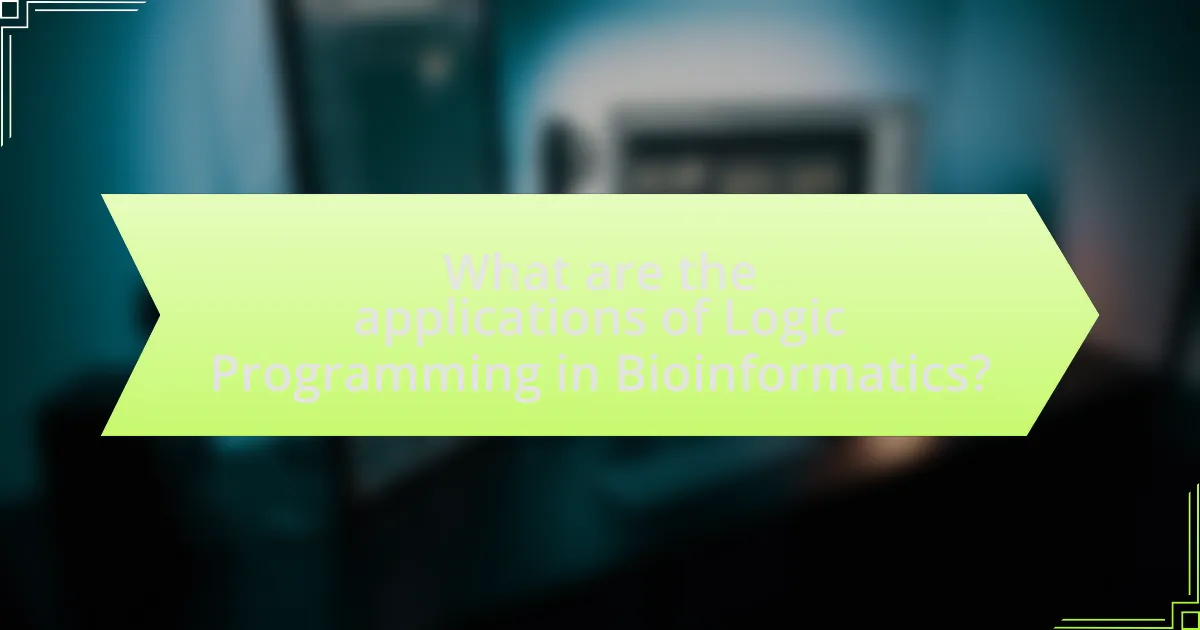
What are the applications of Logic Programming in Bioinformatics?
Logic programming is applied in bioinformatics for tasks such as gene prediction, protein structure prediction, and biological data integration. These applications leverage the declarative nature of logic programming to model complex biological systems and relationships. For instance, Prolog, a common logic programming language, is used to infer relationships between genes and proteins based on existing biological knowledge, enabling researchers to predict gene functions and interactions. Additionally, logic programming facilitates the integration of heterogeneous biological data sources, allowing for more comprehensive analyses of biological phenomena. This approach has been validated in studies that demonstrate improved accuracy in gene function prediction and enhanced data interoperability in bioinformatics projects.
How is Logic Programming used in genomic data analysis?
Logic programming is utilized in genomic data analysis primarily for its ability to represent complex relationships and constraints within biological data. This approach allows researchers to model genetic interactions, infer gene functions, and analyze regulatory networks effectively. For instance, logic programming languages like Prolog enable the encoding of biological knowledge in a way that facilitates automated reasoning, allowing for the discovery of new insights from existing genomic data. Studies have shown that logic programming can enhance the accuracy of gene prediction algorithms and improve the interpretation of high-throughput sequencing data, demonstrating its practical application in the field of bioinformatics.
What algorithms are commonly employed in genomic applications?
Common algorithms employed in genomic applications include Hidden Markov Models (HMMs), Genetic Algorithms (GAs), and Support Vector Machines (SVMs). HMMs are widely used for gene prediction and sequence alignment due to their ability to model biological sequences probabilistically. Genetic Algorithms are utilized for optimization problems in genomics, such as feature selection and parameter tuning, leveraging principles of natural selection. Support Vector Machines are effective in classification tasks, such as distinguishing between different types of genomic data. These algorithms have been validated through numerous studies, demonstrating their effectiveness in analyzing complex genomic datasets and improving predictive accuracy in bioinformatics.
How does Logic Programming facilitate gene prediction?
Logic programming facilitates gene prediction by enabling the representation of complex biological knowledge and relationships in a formal, logical framework. This approach allows for the integration of various data sources, such as genomic sequences and biological annotations, to infer gene structures and functions through logical inference mechanisms. For instance, systems like Prolog have been utilized to model gene regulatory networks, allowing researchers to predict gene interactions and identify potential gene candidates based on established biological rules and relationships. The effectiveness of logic programming in this context is supported by its ability to handle uncertainty and incomplete data, which are common in biological datasets, thereby enhancing the accuracy of gene prediction models.
What role does Logic Programming play in protein structure prediction?
Logic Programming plays a significant role in protein structure prediction by enabling the representation and reasoning of complex biological knowledge. It allows researchers to model the relationships between amino acid sequences and their corresponding three-dimensional structures through logical rules and constraints. For instance, systems like Prolog have been utilized to encode structural information and predict protein folding patterns, demonstrating the effectiveness of Logic Programming in handling combinatorial problems inherent in protein structure prediction. This approach has been validated in studies where Logic Programming frameworks successfully predicted protein structures with high accuracy, showcasing its utility in bioinformatics.
What are the key techniques used in protein structure prediction?
The key techniques used in protein structure prediction include homology modeling, ab initio prediction, and threading. Homology modeling relies on the alignment of a target protein sequence with known structures of homologous proteins, allowing for the inference of the target’s structure based on evolutionary relationships. Ab initio prediction, on the other hand, does not depend on known structures and uses physical and statistical principles to predict the folding of proteins from their amino acid sequences. Threading involves fitting a target sequence onto a known structure template, assessing compatibility based on structural features. These techniques are validated by their widespread application in computational biology, with tools like SWISS-MODEL for homology modeling and Rosetta for ab initio methods demonstrating their effectiveness in accurately predicting protein structures.
How does Logic Programming improve accuracy in protein modeling?
Logic programming improves accuracy in protein modeling by enabling the representation of complex biological knowledge and relationships in a formal, logical structure. This approach allows for the integration of diverse data sources, such as experimental results and theoretical predictions, facilitating more precise modeling of protein structures and functions. For instance, logic programming can utilize constraints and rules to systematically explore conformational space, leading to more accurate predictions of protein folding and interactions. Studies have shown that models incorporating logic programming techniques can achieve higher accuracy rates in predicting protein structures compared to traditional methods, as evidenced by research published in the journal Bioinformatics, which highlights the effectiveness of logic-based approaches in enhancing predictive performance in protein modeling tasks.
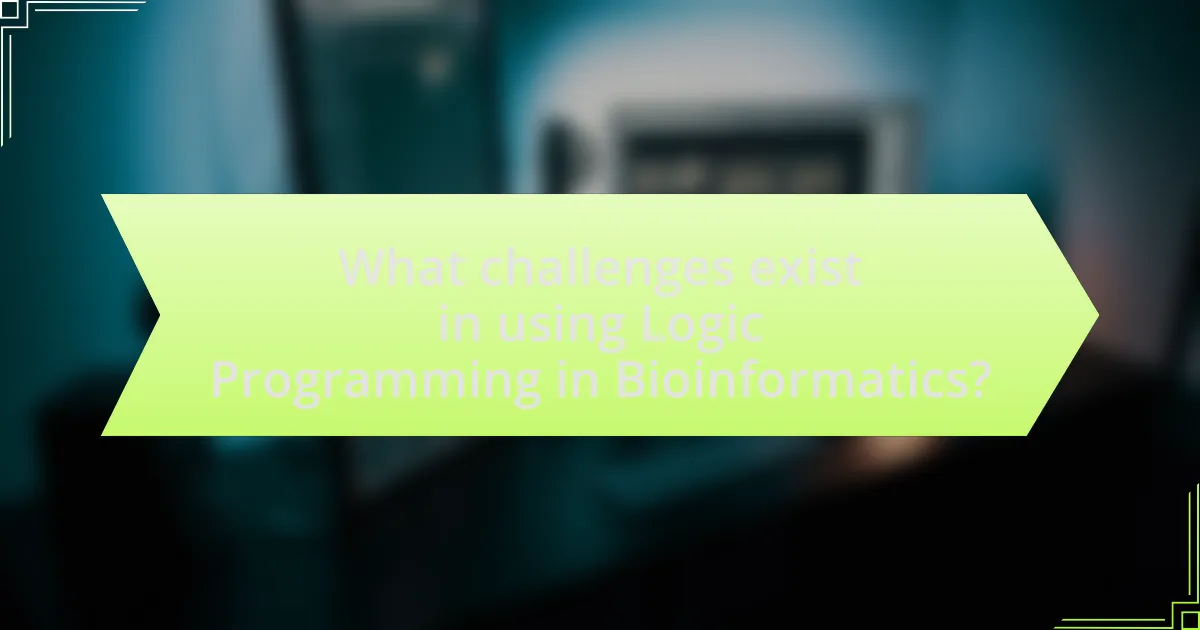
What challenges exist in using Logic Programming in Bioinformatics?
The challenges in using Logic Programming in Bioinformatics include scalability issues, complexity in representing biological knowledge, and difficulties in integrating with existing data systems. Scalability is a significant concern as biological datasets can be vast, making it challenging for logic programming systems to process them efficiently. Additionally, the complexity of biological concepts often requires intricate representations that can be difficult to encode in logic programming languages. Furthermore, integrating logic programming with existing databases and tools in bioinformatics can pose interoperability challenges, limiting its practical application in real-world scenarios.
What are the limitations of Logic Programming in complex biological systems?
Logic programming has significant limitations in modeling complex biological systems due to its inability to effectively handle uncertainty and dynamic changes inherent in biological processes. Biological systems often involve stochastic behaviors and interactions that are not easily represented by the deterministic nature of logic programming. For instance, logic programming relies on fixed rules and facts, which can be inadequate for capturing the variability and adaptability of biological entities, such as gene expression and protein interactions. Additionally, the complexity of biological networks often leads to combinatorial explosion in rule sets, making it computationally infeasible to derive solutions. These limitations highlight the challenges of applying logic programming in bioinformatics, where flexibility and the ability to model uncertainty are crucial for accurate representation and analysis of biological phenomena.
How do computational constraints affect Logic Programming applications?
Computational constraints significantly impact Logic Programming applications by limiting the efficiency and scalability of algorithms used in bioinformatics. These constraints, such as memory limitations and processing power, can hinder the ability to handle large datasets typical in bioinformatics, leading to slower execution times and potential failures in complex queries. For instance, when processing genomic data, the need for extensive backtracking in logic programming can exacerbate performance issues under tight computational resources, making it challenging to derive meaningful insights from large-scale biological data.
What are the challenges in integrating Logic Programming with existing bioinformatics tools?
Integrating Logic Programming with existing bioinformatics tools presents several challenges, primarily due to differences in paradigms and data representation. Logic Programming relies on formal logic and rules, which can complicate the integration with tools that utilize procedural or object-oriented programming paradigms. Additionally, bioinformatics tools often handle large datasets and require efficient algorithms, while Logic Programming may not be optimized for performance in such contexts. Furthermore, the lack of standardized interfaces between Logic Programming systems and bioinformatics applications can hinder interoperability, making it difficult to share data and functionalities. These challenges necessitate the development of bridging frameworks and optimization techniques to facilitate effective integration.
How can researchers overcome these challenges?
Researchers can overcome challenges in using logic programming in bioinformatics by enhancing collaboration across disciplines, improving computational resources, and developing more user-friendly tools. Collaborative efforts between computer scientists and biologists can lead to better integration of logic programming techniques tailored to specific biological problems. Additionally, investing in high-performance computing infrastructure allows researchers to handle large datasets efficiently, which is crucial for bioinformatics applications. Finally, creating intuitive software interfaces can facilitate the adoption of logic programming methods among biologists who may lack programming expertise, thereby broadening the user base and enhancing research outcomes.
What best practices should be followed when implementing Logic Programming in Bioinformatics?
When implementing Logic Programming in Bioinformatics, best practices include ensuring clear problem definition, utilizing efficient algorithms, and maintaining modular code structure. Clear problem definition allows for targeted solutions, which is essential in complex biological data analysis. Efficient algorithms, such as those based on Prolog, enhance performance in reasoning tasks, which is critical given the large datasets in bioinformatics. Maintaining a modular code structure facilitates easier debugging and enhances collaboration among researchers, as evidenced by successful projects like the Bioinformatics Toolkit, which emphasizes modularity for scalability and adaptability in research applications.
How can collaboration between disciplines enhance the use of Logic Programming?
Collaboration between disciplines can enhance the use of Logic Programming by integrating diverse expertise, which leads to more robust problem-solving approaches. For instance, in bioinformatics, the combination of computer science, biology, and mathematics allows for the development of sophisticated algorithms that can efficiently process biological data. This interdisciplinary synergy enables the application of Logic Programming to model complex biological systems, facilitating tasks such as gene prediction and protein structure analysis. Studies have shown that interdisciplinary teams can produce innovative solutions that single-discipline teams may overlook, thereby improving the effectiveness and applicability of Logic Programming in addressing real-world biological challenges.
What are the future prospects of Logic Programming in Bioinformatics?
The future prospects of Logic Programming in Bioinformatics are promising, particularly in areas such as data integration, knowledge representation, and automated reasoning. Logic Programming’s declarative nature allows for the effective modeling of complex biological systems and relationships, facilitating the analysis of large datasets. For instance, the use of Prolog in bioinformatics has been shown to enhance the development of algorithms for gene prediction and protein structure prediction, as evidenced by studies that demonstrate improved accuracy in these domains. Additionally, as biological data continues to grow exponentially, the ability of Logic Programming to handle uncertainty and incomplete information will become increasingly valuable, making it a critical tool for future bioinformatics applications.
How might advancements in technology impact Logic Programming applications?
Advancements in technology will enhance Logic Programming applications by improving computational efficiency and enabling more complex problem-solving capabilities. For instance, the development of faster processors and parallel computing allows Logic Programming systems to handle larger datasets and more intricate logical queries, which is particularly beneficial in fields like bioinformatics where data complexity is high. Additionally, advancements in machine learning and artificial intelligence can integrate with Logic Programming, facilitating automated reasoning and knowledge discovery, thus streamlining processes such as genomic data analysis and protein structure prediction. These technological improvements are evidenced by the increasing adoption of Logic Programming in bioinformatics tools, which leverage enhanced algorithms and computational power to deliver more accurate and timely insights.
What emerging trends should researchers watch for in this field?
Researchers should watch for the increasing integration of machine learning techniques with logic programming in bioinformatics. This trend is driven by the need for more efficient data analysis and interpretation in complex biological datasets. For instance, the combination of logic programming’s declarative nature with machine learning’s predictive capabilities allows for enhanced modeling of biological processes, as evidenced by studies showing improved accuracy in genomic data interpretation when these methods are used together. Additionally, the rise of explainable AI in bioinformatics highlights the importance of transparency in algorithmic decision-making, which aligns well with the principles of logic programming.
What practical tips can enhance the use of Logic Programming in Bioinformatics?
To enhance the use of Logic Programming in Bioinformatics, practitioners should focus on integrating domain-specific knowledge into logic-based systems. This integration allows for more accurate modeling of biological processes and relationships. For instance, utilizing ontologies such as Gene Ontology can improve the representation of biological concepts and facilitate reasoning about gene functions. Additionally, leveraging existing logic programming frameworks, like Prolog, can streamline the development of bioinformatics applications by providing built-in mechanisms for handling complex queries and data relationships. Furthermore, collaboration with biologists to refine the logic models ensures that the programming aligns with real-world biological scenarios, enhancing the relevance and applicability of the solutions developed.
